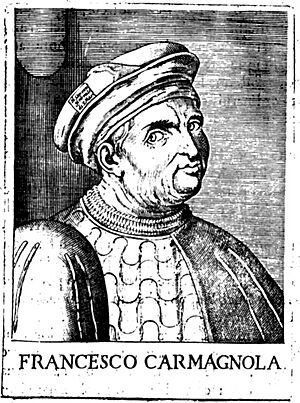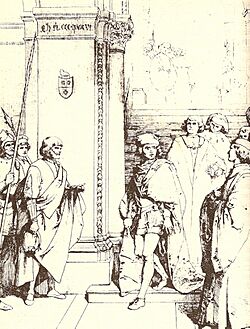Francesco Bussone da Carmagnola facts for kids
Francesco Bussone, often called the Count of Carmagnola, was a famous Italian military leader. He lived a long time ago, from about 1382 to 1432. He was known as a condottiero, which was a captain who led groups of soldiers for hire in Italy during the Middle Ages and Renaissance.
Contents
The Early Life of Carmagnola
Francesco Bussone was born in a small town called Carmagnola, near Turin. He came from a simple farming family. He started his military career very young, at just twelve years old! He first worked for a powerful military captain named Facino Cane. Later, he served Gian Galeazzo Visconti, who was the Duke of Milan.
Working for the Duke of Milan
When Facino Cane died, his lands were split among his captains. But Gian Galeazzo's son, Filippo Maria Visconti, wanted to get all the lands back. He asked Carmagnola, who was about 30 years old, to lead his army. Carmagnola was incredibly successful! He quickly took control of many cities like Bergamo, Brescia, Parma, and Genoa. Soon, the entire area was back under Visconti's rule.
Filippo Maria rewarded Carmagnola for his great victories. However, he also worried that Carmagnola might become too powerful. So, instead of giving him more military commands, he made Carmagnola the governor of Genoa.
Joining the Venetians
Carmagnola felt very upset by this decision. He tried to talk to the Duke, but he couldn't get a meeting. Because of this, he left his job and offered his skills to the Venetians in 1425.
The city of Venice welcomed him. The Republic of Venice was starting to worry about how powerful Visconti was becoming. The new leader of Venice, called the Doge, Francesco Foscari, wanted to team up with the Florentines and go to war against Milan. Carmagnola told the Venetians that Visconti's army was not as strong as people thought. He said it was the perfect time to attack. These arguments, along with the Doge's desire for war, convinced them. Carmagnola was made the captain-general of Venice in 1426, and war was declared.
The Long War and Its End
The Republic of Venice wanted quick and decisive victories. But Carmagnola, like many other soldiers for hire, found it was better for him if the war lasted a long time. He avoided big, final battles and often released prisoners quickly. Because of this, the war went on and on. Some battles were won, others were lost. Peace treaties were made, only to be broken. Nothing was ever truly decided.
Carmagnola's most important success was the battle of Maclodio in 1427. But even after this victory, he didn't follow up with more attacks. The Venetians grew impatient with his slow pace. They even offered him more money and huge land rewards, including control of Milan, to make him fight harder. But it didn't work.
At the same time, Carmagnola was secretly getting messages from Visconti. Visconti offered him great rewards if he would leave the Venetians. Carmagnola played games with both his old and new employers. He foolishly believed he controlled the fate of both sides. But the Venetians were not easy to trick. When they finally lost all patience, the Council of Ten decided to bring him to justice.
On March 29, 1432, Carmagnola was called to Venice to talk about future plans. He came without suspecting anything. When he arrived at the ducal palace, he was arrested and put in prison. He was then put on trial for treason against the Republic. Even though the Doge tried to help him, he was found guilty. Carmagnola was condemned to death and executed on May 5, 1432. He was a very skilled leader, but he made a big mistake by thinking he could trick a strong government like Venice.
Carmagnola in Culture
Francesco Bussone's story has inspired many artists and writers.
- The famous Italian writer Alessandro Manzoni wrote a play about him called Il Conte di Carmagnola in 1820.
- An opera called Le Comte de Carmagnola was created in 1841. It had words by Eugène Scribe and music by Ambroise Thomas.
- Carmagnola is also a character in Rafael Sabatini's adventure novel Bellarion. In the book, he is shown as a bit boastful and becomes a minor enemy.
- There is a sculpted head made of a stone called porphyry on the outside of St Mark's Basilica in Venice. Many people think it looks like an old emperor named Justinian. But after Carmagnola's execution, it was nicknamed Carmagnola.



